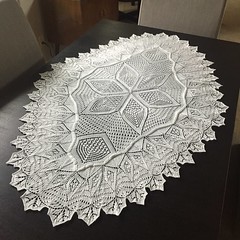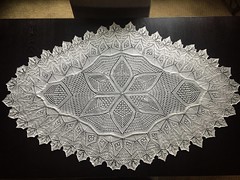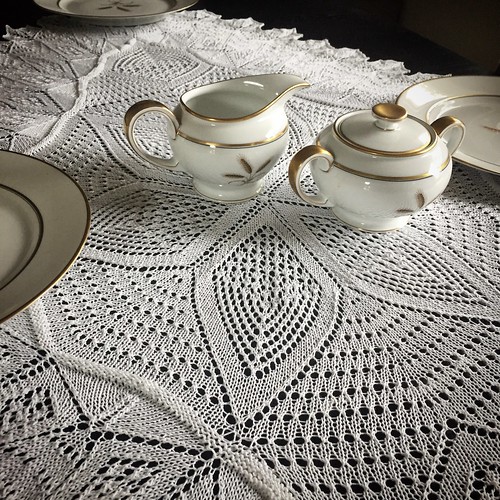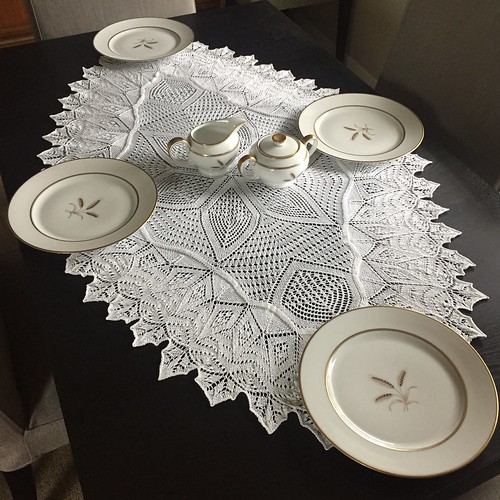This one is Flieder, another Herbert Neibling design, but about three times larger than the Georg doily I made last month. Flieder is German for lilac. Neibling produced more than one pattern with this name, but I'm not sure how he saw anything bout lilacs in this particular pattern. The central flower has six petals, and little lilac blossoms have four. Still, it's Neibling's world and we're just living in it. Flieder it is
While shopping for thread -- and I got each of the three balls from three different craft stores in Austin -- I saw that Aunt Lydia's Classic Crochet 10 comes in a light purple, dare I say, lilac color. But that would have been a bit too literal and I would never have used it. White is the way to go with this, I think.
For those interested in such things, here's a little schematic of how this particular sausage was made.The central portion, marked in green, starts with 6 stitches in the middle, one for each petal that grows outward, knit in the round. After completing that, the two sections marked in, let's say, lilac, are knit flat (back and forth). After this, stitches are picked up around the purple sections along with the held live stitches from the remainder of the green so that the work is again done in the round. Four rounds of dense purling with the thread held doubled follow, and then 20 repeats of the pattern are knit up to the orange line. After that, the pattern shifts to 40 repeats. That's a lot of stitch markers. And a lot of stitches on the needle. By the end, there were 1,440 stitches on a 32" needle. I don't have a US0 (2mm) 47" circular needle. I wish I did. Things got quite crowded. I also experienced that weird thing with center-out projects -- the closer you get to the end, the slower your progress. It can be a bit maddening. Everything up to the orange line took 5 or 6 days to knit. Everything outside of that took an additional two weeks.
Please don't think that all this explanation is meant to impress, or to warn you off lace knitting. My point is that it's not nearly as hard you might think. I've made two oval examples, which are probably more fiddly than most. I would think that a square table cloth or round doily would be a bit easier, but just having a basic idea of the construction, using Google Translate, and finding some online German/English knitting glossaries is all you really need to get started. Then it's just a matter of not dropping stitches and not loosing one's place in the pattern. And time.
This fits our dining table perfectly, which was a fluke, really. I just lucked out on that one. I'll likely just use it for special occasions. This morning, I set out some of my Grandma Self's china on it to see what it looks like. The story in the family is that my grandmother didn't really even want fancy china, but my grandfather insisted that they get some while they were living Germany after WWII and had the means -- they'd been so poor when they got married during the Great Depression. It came down to me eventually. A scent I noticed as a I was pulling it out of the cabinet triggered a sense memory of my grandparents house and Thanksgiving dinners in San Antonio. And they look great together, I think, German dishes on a German-designed doily. My family has had so many connections to Germany -- my Kohrs and Weber ancestors immigrating from there to Texas in the 1850s, my grandparents and father living there 100 years later, and my brother's family making their lives there now.
Only 109 days until Thanksgiving!




